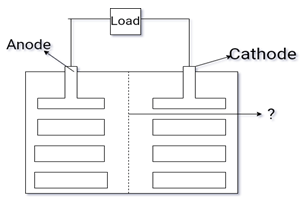This set of Automotive Engine Auxiliary Systems Multiple Choice Questions & Answers (MCQs) focuses on “Lithium-Ion Battery”.
1. Which of the following as shown below avoids the direct contact of the positive and negative plate in a lithium-ion battery?

a) Electrolyte
b) Separator
c) Load
d) Rectifier
View Answer
Explanation: The separator avoids the direct contact and thus short-circuiting of positive and negative plates, thin sheets of some non-conducting material are inserted between them. These sheets are called as separators.
2. Which is the electrolyte used in Li-ion battery?
a) Lead dioxide
b) Lithium-based gel
c) Sulfur dioxide
d) Cobalt
View Answer
Explanation: Lithium-ion batteries also work by shuttling ions between the electrode. During charging, ions travel in one direction; during the discharging process, they go in the other direction. The electrolyte is a lithium-based gel or polymer.
3. Which of the following statement is true for the movement of electrons concerning the direction of current?
a) Same as the direction of current
b) Opposite direction of current
c) Does not depend on the direction of current
d) No movement of electrons
View Answer
Explanation: During the charging mechanism of lithium-ion battery the current flows from the anode to the cathode whereas the electrons present in the cathode move from cathode to anode thus the movement of the electrons is opposite when compared to the direction of current flow.
4. Which is the material used to as anode in a lithium-ion battery?
a) Brass foil coated with graphite
b) Aluminum foil coated with graphite
c) Copper foil coated with graphite
d) Stainless steel coated with graphite
View Answer
Explanation: The Lithium-ion battery having round Li-ion cells employ anodes of aluminum foils coated with graphite and is soaked with an organic electrolyte, which enables the transfer of lithium ions in the first place.
5. Which of the following is not a disadvantage of a lithium-ion battery?
a) Complex to manufacture
b) Sophisticated chargers
c) More expensive
d) High energy density
View Answer
Explanation: The disadvantages of a lithium-ion battery are it is more expensive,since these are more complex to manufacture. These require a sophisticated charger to carefully monitor the charging process which makes it more complex. Whereas high energy density is the advantage of the lithium-ion battery.
6. Which of the following is formed at the graphite electrode during the charging process of a battery when the lithium-ion move through the separator?
a) Water
b) Graphite
c) Lithium hydroxide
d) Lithium carbide
View Answer
Explanation: During the charging process, lithium ions are released from the metal oxide and move through the separator to the graphite electrode where lithium carbide is formed. The energy stored in the charging process can be released again by the inverse chemical reaction.
7. What is the range of specific energy in Watt-hour per kg in a lithium-ion battery?
a) 0-50
b) 100-265
c) 50-60
d) 60-100
View Answer
Explanation: Lithium-ion battery has a promising future as a rechargeable battery for the electric hybrid vehicle due to its very high storage capacity,which ranges from 100-265 watt-hour per kg with the fact that it operates at room temperature.
8. Which is the material used as a cathode in a lithium-ion battery?
a) Zinc foils coated lithium metal oxide
b) Brass foil coated with graphite metal oxide
c) Aluminum foils coated with graphite metal oxide
d) Copper foils coated with lithium metal oxide
View Answer
Explanation: The lithium-ion batteries having round Li-ion cells employ anode of aluminum foils coated with graphite and cathodes of copper foils coated with lithium metal oxide. The wound electrodes are soaked with an organic electrolyte.
9. What is the maximum storage temperature in degree centigrade of a Li-ion battery?
a) 30
b) 50
c) 60
d) 40
View Answer
Explanation: Lithium-ion batteries should not be stored at temperatures above 60 degrees centigrade and operated at above 40 degrees centigrade. Likewise there is an appreciable reduction in the potential charging and discharging rate below -5 degrees centigrade.
10. Which of the following is not an advantage of Lithium-ion battery?
a) High specific energy density
b) More expensive
c) Reliability
d) Lower self-discharge rate
View Answer
Explanation: The lithium-ion battery has many advantages like higher specific energy density than most other types,lower self-discharge rate, has much greater reliability whereas the disadvantage of the li-ion battery is that it is more expensive,since complex to manufacture.
11. Which of the following material is used as separator material in Lithium-ion battery?
a) Brass
b) Metal sheet
c) Paper
d) Plastic
View Answer
Explanation: The lithium-ion battery employ anodes of aluminum foils coated with graphite and cathodes of copper foils coated with lithium metal oxide. A.plastic separator separates the anode and the cathodes. The wound electrode is soaked with an organic electrolyte.
12. Which of the following circuit is used for cooling of the lithium-ion battery?
a) Air conditioning
b) Heater circuit
c) Ignition circuit
d) EGR circuit
View Answer
Explanation: For cooling, the heat from the battery can be dissipated only through the air conditioning circuit. The battery heat from the refrigerant circuit of the air conditioning system can be transferred,using conditioned air, a dedicated coolant circuit.
13. What is the maximum operating temperature in degree centigrade above which the lithium-ion battery should not be operated?
a) 10
b) 20
c) 30
d) 40
View Answer
Explanation: Li-ion batteries have a maximum operating temperature should not be above 40-degree centigrade. Operating the Li-ion battery beyond this temperature range shortens the battery life due to irreversible damage occurring within the Li-ion cells.
Sanfoundry Global Education & Learning Series – Automotive Engine Auxiliary Systems.
To practice all areas of Automotive Engine Auxiliary Systems, here is complete set of 1000+ Multiple Choice Questions and Answers.
If you find a mistake in question / option / answer, kindly take a screenshot and email to [email protected]
- Apply for Mechanical Engineering Internship
- Practice Mechanical Engineering MCQs
- Check Automotive Engine Design Books
- Check Mechanical Engineering Books
